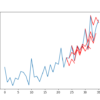The data for your sequence prediction problem probably needs to be scaled when training a neural network, such as a Long Short-Term Memory recurrent neural network. When a network is fit on unscaled data that has a range of values (e.g. quantities in the 10s to 100s) it is possible for large inputs to slow […]










